When testing Einstein's theory of general relativity, small modeling errors add up fast
2021-06-16
(Press-News.org) Small modeling errors may accumulate faster than previously expected when physicists combine multiple gravitational wave events (such as colliding black holes) to test Albert Einstein's theory of general relativity, suggest researchers at the University of Birmingham in the United Kingdom. The findings, published June 16 in the journal iScience, suggest that catalogs with as few as 10 to 30 events with a signal-to-background noise ratio of 20 (which is typical for events used in this type of test) could provide misleading deviations from general relativity, erroneously pointing to new physics where none exists. Because this is close to the size of current catalogs used to assess Einstein's theory, the authors conclude that physicists should proceed with caution when performing such experiments.
"Testing general relativity with catalogs of gravitational wave events is a very new area of research," says Christopher J. Moore, a lecturer at the School of Physics and Astronomy & Institute for Gravitational Wave Astronomy at the University of Birmingham in the United Kingdom and the lead author of the study. "This is one of the first studies to look in detail at the importance of theoretical model errors in this new type of test. While it is well known that errors in theoretical models need to be treated carefully when you are trying to test a theory, we were surprised by how quickly small model errors can accumulate when you start combining events together in catalogs."
In 1916, Einstein published his theory of general relativity, which explains how massive celestial objects warp the interconnected fabric of space and time, resulting in gravity. The theory predicts that violent outer space incidents such as black hole collisions disrupt space-time so severely that they produce ripples called gravitational waves, which zoom through space at the speed of light. Instruments such as LIGO and Virgo have now detected gravitational wave signals from dozens of merging black holes, which researchers have been using to put Einstein's theory to the test. So far, it has always passed. To push the theory even further, physicists are now testing it on catalogs of multiple grouped gravitational wave events.
"When I got interested in gravitational wave research, one of the main attractions was the possibility to do new and more stringent tests of general relativity," says Riccardo Buscicchio, a PhD student at the School of Physics and Astronomy & Institute for Gravitational Wave Astronomy and a co-author of the study. "The theory is fantastic and has already passed a hugely impressive array of other tests. But we know from other areas of physics that it can't be completely correct. Trying to find exactly where it fails is one of the most important questions in physics."
However, while larger gravitational wave catalogs could bring scientists closer to the answer in the near future, they also amplify the potential for errors. Since waveform models inevitably involve some approximations, simplifications, and modeling errors, models with a high degree of accuracy for individual events could prove misleading when applied to large catalogs.
To determine how waveform errors grow as catalog size increases, Moore and colleagues used simplified, linearized mock catalogs to perform large numbers of test calculations, which involved drawing signal-to-noise ratios, mismatch, and model error alignment angles for each gravitational wave event. The researchers found that the rate at which modeling errors accumulate depends on whether or not modeling errors tend to average out across many different catalog events, whether deviations have the same value for each event, and the distribution of waveform modeling errors across events.
"The next step will be for us to find ways to target these specific cases using more realistic but also more computationally expensive models," says Moore. "If we are ever to have confidence in the results of such tests, we must first have as a good an understanding as possible of the errors in our models."
INFORMATION:
This work was supported by a European Union H2020 ERC Starting Grant, the Leverhulme Trust, and the Royal Society.
iScience, Moore et al.: "Testing general relativity with gravitational-wave catalogs: the insidious nature of waveform systematics" https://www.cell.com/iscience/fulltext/S2589-0042(21)00545-9
iScience (@iScience_CP) is an open access journal from Cell Press that provides a platform for original research and interdisciplinary thinking in the life, physical, and earth sciences. The primary criterion for publication in iScience is a significant contribution to a relevant field combined with robust results and underlying methodology. Visit: http://www.cell.com/iscience. To receive Cell Press media alerts, contact press@cell.com.
ELSE PRESS RELEASES FROM THIS DATE:
2021-06-16
Human babies do even more than we thought while sleeping.
A new study from University of Iowa researchers provides further insights into the coordination that takes place between infants' brains and bodies as they sleep.
The Iowa researchers have for years studied infants' twitching movements during REM sleep and how those twitches contribute to babies' ability to coordinate their bodily movements. In this study, the scientists report that beginning around three months of age, infants see a pronounced increase in twitching during a second major stage of sleep, called quiet sleep.
"This was completely surprising and, for all we know, ...
2021-06-16
When Betelgeuse, a bright orange star in the constellation of Orion, lost more than two-thirds of its brightness in late 2019 and early 2020, astronomers were puzzled.
What could cause such an abrupt dimming?
Now, in a new paper published Wednesday in Nature, an international team of astronomers reveal two never-before-seen images of the mysterious darkening --and an explanation. The dimming was caused by a dusty veil shading the star, which resulted from a drop in temperature on Betelgeuse's stellar surface.
Led by Miguel Montargès at the Observatoire de Paris, the new images were taken in January and March of 2020 using the European Southern Observatory's Very Large Telescope. Combined with images previously taken in ...
2021-06-16
EMBARGOED UNTIL 11 A.M. ET WEDNESDAY, JUNE 16, 2021
MADISON, Wis. -- Quantum computers could outperform classical computers at many tasks, but only if the errors that are an inevitable part of computational tasks are isolated rather than widespread events. Now, researchers at the University of Wisconsin-Madison have found evidence that errors are correlated across an entire superconducting quantum computing chip -- highlighting a problem that must be acknowledged and addressed in the quest for fault-tolerant quantum computers.
The researchers report their findings in a study published June 16 in the journal Nature, Importantly, their work also points to mitigation strategies.
"I think people have been approaching the problem of error correction in an overly optimistic ...
2021-06-16
It is possible to re-create a bird's song by reading only its brain activity, shows a first proof-of-concept study from the University of California San Diego. The researchers were able to reproduce the songbird's complex vocalizations down to the pitch, volume and timbre of the original.
Published June 16 in Current Biology, the study lays the foundation for building vocal prostheses for individuals who have lost the ability to speak.
"The current state of the art in communication prosthetics is implantable devices that allow you to generate textual output, writing up to 20 words per minute," said senior author Timothy Gentner, a professor of psychology and neurobiology ...
2021-06-16
When Betelgeuse, a bright orange star in the constellation of Orion, became visibly darker in late 2019 and early 2020, the astronomy community was puzzled. A team of astronomers have now published new images of the star's surface, taken using the European Southern Observatory's Very Large Telescope (ESO's VLT), that clearly show how its brightness changed. The new research reveals that the star was partially concealed by a cloud of dust, a discovery that solves the mystery of the "Great Dimming" of Betelgeuse.
Betelgeuse's dip in brightness -- a change noticeable even to the ...
2021-06-16
What The Study Did: Researchers examined to what extent cannabis use is associated with thickness in brain areas measured by magnetic resonance imaging in a study of adolescents.
Authors: Matthew D. Albaugh, Ph.D., of the University of Vermont Larner College of Medicine in Burlington, is the corresponding author.
To access the embargoed study: Visit our For The Media website at this link https://media.jamanetwork.com/
(10.1001/jamapsychiatry.2021.1258)
Editor's Note: The article includes conflict of interest and funding/support disclosures. Please see the article for additional information, including other authors, author contributions and affiliations, conflict of interest and financial disclosures, and funding and support.
INFORMATION:
Media advisory: The ...
2021-06-16
What The Study Did: Survival among people with early-onset (diagnosed before age 50) colorectal cancer compared with later-onset colorectal cancer (diagnosed at ages 51 through 55) was compared using data from the National Cancer Database.
Authors: Charles S. Fuchs, M.D., M.P.H., of the Yale School of Public Health in New Haven, Connecticut, is the corresponding author.
To access the embargoed study: Visit our For The Media website at this link https://media.jamanetwork.com/
(doi:10.1001/jamanetworkopen.2021.12539)
Editor's Note: The article includes conflicts of interest and funding/support disclosures. Please see the article for additional information, including other authors, author contributions and affiliations, conflict of interest and financial disclosures, and funding and ...
2021-06-16
What The Study Did: This study demonstrated an association between receiving the mRNA-1273 (Moderna) vaccine and a reduction in SARS-CoV-2 infection in health care workers beginning eight days after the first dose.
Authors: Michael E. Charness, M.D., of the VA Boston Healthcare System in West Roxbury, Massachusetts, is the corresponding author.
To access the embargoed study: Visit our For The Media website at this link https://media.jamanetwork.com/
(doi:10.1001/jamanetworkopen.2021.16416)
Editor's Note: The article includes conflict of interest ...
2021-06-16
A ball of 4,000-year-old hair frozen in time tangled around a whalebone comb led to the first ever reconstruction of an ancient human genome just over a decade ago.
The hair, which was preserved in arctic permafrost in Greenland, was collected in the 1980s and stored at a museum in Denmark. It wasn't until 2010 that evolutionary biologist Professor Eske Willerslev was able to use pioneering shotgun DNA sequencing to reconstruct the genetic history of the hair.
He found it came from a man from the earliest known people to settle in Greenland ...
2021-06-16
Stimulation of the nervous system with neurotechnology has opened up new avenues for treating human disorders, such as prosthetic arms and legs that restore the sense of touch in amputees, prosthetic fingertips that provide detailed sensory feedback with varying touch resolution, and intraneural stimulation to help the blind by giving sensations of sight.
Scientists in a European collaboration have shown that optic nerve stimulation is a promising neurotechnology to help the blind, with the constraint that current technology has the capacity of providing only simple visual signals.
Nevertheless, the scientists' vision (no pun intended) is to design these simple visual signals to be meaningful in assisting the blind with daily living. Optic nerve stimulation ...
LAST 30 PRESS RELEASES:
[Press-News.org] When testing Einstein's theory of general relativity, small modeling errors add up fast

